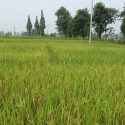29 Sep 2018
Temporal and spatial changes in soil available phosphorus in China (1990–2012)
Ma JC, He P*, Xu XP, He WJ, Liu YX, Yang FQ, Chen F, Li ST, Tu, SH, Jin JY, Johnston A, Zhou W. Temporal and spatial changes in soil available phosphorus in China (1990–2012). Field Crops Research, 2016, 192:13-20. http://dx.doi.org/10.1016/j.fcr.2016.04.006

Mineral fertilizers have played a critical role in increasing cereal crop production in China. However, the use of fertilizer at rates in excess of crop removal or to support soil health has resulted in serious environmental problems, this hindering sustainable agriculture development. In order to support crop production and reduce potential environmental risks, it is essential that every effort is made to promote an efficient and effective use of phosphorus (P) resources. In this paper, the temporal and spatial changes of soil available P was analyzed using 59,956 soil samples, combined with the results of 4837 field experiments compiled from the International Plant Nutrient Institute (IPNI) China program database from 1990 to 2012. The results demonstrated that soil available P content showed an increasing trend with a slope of 1.51 from 1990 to 2012. However, this trend for all samples was separated into cash crops(with a slope of 2.75) and grain crops (with a slope of 0.76) revealing that it was cash crops that were primarily responsible for the increasing trend. Field trail results revealed that it was the high P fertilizer application rates to cash crops that resulted in the increase of soil available P. On average, for all crops, the soil analysis data showed that soil available P increased from 17.09 mg/L in the 1990s (from 1990 to 2000) to 33.28 mg/L in the 2000s (from 2001 to 2012), again mainly due to the large increase in cash crop area in China. For relative yield, there was little to no variation across regions (with mean values of87.8%, 87.8%, 84.4%, 88.1% and 86.0% for the NE, NC, NW, SE and SW regions, respectively), but the trend of variation showed great differences in those same regions from the 1990s to the 2000s. The relative yield for grain crops in the NE, NC, SE and SW increased by 2.6%, 7.9%, 6.9% and 8.6%, but decreased by 4.9% in the NW from the 1990s to the 2000s. The relative yield for cash crops decreased by 6.7%, 6.0% and 1.6% for the NE, SE and SW regions, but increased by 8.3% and remained unchanged for the NC and NW regions, respectively. The great variation observed in soil available P across the different regions in China demonstrated the urgent need for site-specific P nutrient management. In conclusion, while P fertilizer application should meet the requirements for all types of crops, it must be managed to avoid the potential for negative environmental impacts.




